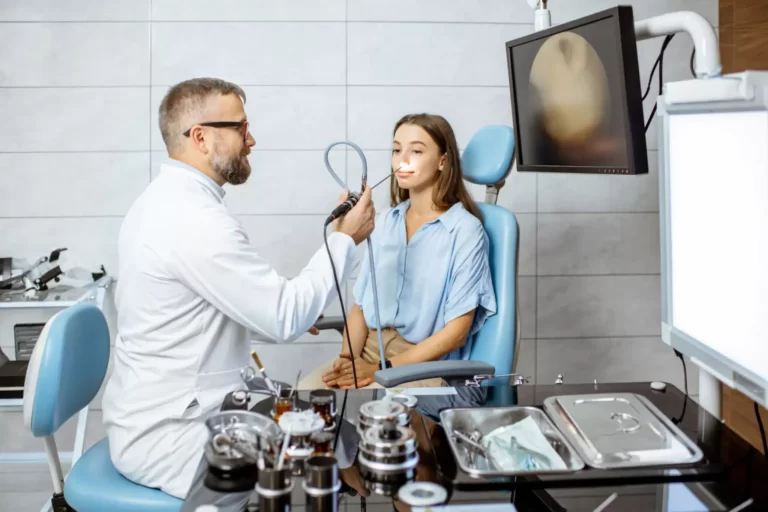Endoscopic Sinus Surgery /
Functional Endoscopic Sinus Surgery
Home | Services | Sinus Conditions | Endoscopic Sinus Surgery
What Is Endoscopic Sinus Surgery (ESS) / Functional Endoscopic Sinus Surgery (FESS)?
Endoscopic Sinus Surgery (ESS), also known as Functional Endoscopic Sinus Surgery (FESS), is a surgical procedure used to remove blockage and lesions in the sinuses. Your sinus doctor will use a thin camera with a light on the end called an endoscope, will be used to magnify and see inside the sinuses. Specialized instruments will then be used to remove any sinus blockage / lesions such as nasal polyps or scar tissue. Straightening the septum and reducing the size of the turbinates may also be done, if necessary. FESS is performed completely through the nostrils and does not involve cutting the skin or any external scarring.
The principle of FESS is that when the underlying cause of disease is found, that problem is corrected eliminating more extensive surgery. Secondary problems will usually resolve when the primary problem is corrected. This may require regular antibiotics, nasal irrigations, and nasal sprays even after surgery.
Is Endoscopic Sinus Surgery Used To Treat Sinusitis Or Chronic Sinusitis?
Endoscopic sinus surgery is an option to treat sinusitis or chronic sinusitis when the patient has failed maximal medical treatment. This is generally a treatment of last resort and the pros and cons of the procedure will be discussed extensively with the patient.
What Are The Advantages Of Endoscopic Sinus Surgery?
Endoscopic Sinus Surgery preserves much more normal tissue compared to conventional open sinus surgery. Also, precision surgery can be performed without nasal packing. The result is faster healing and less postoperative discomfort.

What is Image Guidance in Endoscopic Sinus Surgery?
Image-guided systems (IGS) are essentially like GPS (Global Positioning Satellite) systems for the anatomy of your sinuses. These systems are used to aid the surgeon in the confirming the location of critical structures when the interior of the nose and sinuses is distorted by unusual anatomy or prior surgery.
Most endoscopic sinus surgery is now performed with IGS. Initially, a CT scan of the sinuses, is performed using a specific navigation system protocol. The CT scan is transferred to a disc, which is then loaded into the IGS computer.
During surgery, a detection array is placed on the patient’s head. The CT scan images loaded into the system are then calibrated to the patient’s anatomy using set pre-set reference points, which are specific anatomic points on the face. The position of the sinus surgery instruments can then be tracked by the computer by integrating the information detected from the patient’s pre-set reference points and comparing it to the information on the CT scan in real-time.
IGS has greatly improved the safety and efficacy of endoscopic sinus surgery, By providing 3-Dimensional visualization, this enables surgeons to locate and avoid critical structures, such as the nerve to the eye and region of the brain, while safely clearing disease from the sinuses.
What Can I Expect In Endoscopic Sinus Surgery?
Endoscopic sinus surgery is performed by a sinus specialist, and most commonly done under general anesthesia, and may take anywhere from 2-3 hours to perform. Nasal packing is usually not required, but return visits are necessary after surgery to clean the sinus cavities and monitor the healing process.
Please take your prescribed pain medication prior to your postoperative visits to make the cleaning procedure more comfortable. These visits are routinely scheduled every 7-14 days until the nose is healing well and then less frequently. You will participate in your care by taking prescribed medications and irrigating your nose with salt water at least four times per day. If packing is required, you will return in a few days after surgery for removal.
Though endoscopic sinus surgery has been a breakthrough improvement in the treatment of sinus disease, it unfortunately does not always cure everyone. Some patients, especially those with nasal polyps may have recurrent disease. In some cases, repeat endoscopic surgery may be necessary for disease which recurs.

What Are The Complications, Risks and Alternatives of Endoscopic Surgery?
In general the complications and risks of endoscopic surgery are the same as those for conventional intranasal sinus surgery, however, because of better visualization, special instrumentation and better training of the sinus specialist, the risks of surgery are reduced. Nevertheless, each patient should be aware of the potential complications.
Bleeding
Bleeding is a possibility in any nasal or sinus surgery as the blood supply is extensive. Occasionally significant bleeding may occur requiring termination of the procedure and nasal packing. This usually requires hospitalization for observation. Blood transfusions are rare, as is the need for subsequent surgery to control bleeding. However, certain precautions are necessary, such as the avoidance of all certain painkillers as well as supplements such as garlic, ginseng, and gingko for a period of 2 weeks before surgery. Patients on long-term blood thinning agents can still undergo surgery though their medication regime or type may need to be temporarily altered.
Failure to Cure the Problem / Recurrent Disease
Disease may not be cured by endoscopic sinus surgery or may recur at a later time. Whilst endoscopic surgery reduces the chances of this occurring, a risk of persistent or recurrent disease is possible which may require subsequent further intervention.
Postoperative Discharge
Postsurgical blood-tinged drainage or clots may occur for up to two weeks after surgery. This is not abnormal and will clear. Blowing of the nose should not be attempted for at least three weeks after surgery.
Risk of Anaesthesia
Although this procedure may be performed under local anesthesia, most patients prefer general anesthesia. Although usually safe, general anesthesia has some risks and complications. We can put you in touch with our anaesthesists to discuss this issue further if necessary.
Cerebrospinal Fluid Leak / Brain injury
The brain is adjacent to the nose with a thin layer of bone separating them. There is a risk of breaching this thin bony wall separating the nose from the brain. A thin clear fluid that surrounds the brain can then leak into the nose. This fluid can become infected and an infection of the lining of the brain and spinal cord called meningitis can potentially occur. However, this complication is rare. If a leak does occur, an attempt will be made to fix this during surgery, which is usually successful. Further endoscopic sinus surgery to close the hole may be necessary if the leak persists. Better visualization and the use of image guidance often helps to reduce this complication even further. Patients with extensive sinus disease or nasal polyps are at higher risk of this. Injuries to the brain may also occur if this thin bony wall is breached. Complications may take the form of injury to brain matter, bleeding inside the brain, as well as air entering the skull causing compression on the brain. Fortunately, these complications are all extremely rare.
Loss of Vision
The eye is also adjacent to the nose with a thin layer of bone separating them. If this thin layer of bone is breached, problems with the eye may result. This may range from persistent tearing, double vision, and in extremely rare cases – blindness. The incidence of such issues have been reduced with image guidance reduces this risk.
Other Risks
You may note some numbness or discomfort in the front and upper teeth temporarily. Swelling over the nose/face, bruising, “black eyes”, and lip numbness may also occur, but usually resolve in one to two weeks. Air may also collect under the skin around the eye postoperatively. This rapidly resolves. Symptoms may return or in some cases worsen such as sinus pain or discomfort, increased nasal obstruction or discharge. Smell may be decreased or absent after surgery, but this is rare. Scarring may occur in the nose, but usually does not cause a problem on occasion the scarring may need to be removed via a separate procedure.
Alternatives to Surgery
Medical therapy if successful, is the treatment of choice. If unsuccessful, you may choose to tolerate the symptoms rather than have surgery. Besides endoscopic sinus surgery, conventional sinus surgery is available, but very rarely performed. Depending on the extent of the disease, treatment without surgery may lead to orbital complication (loss of vision), brain abscess or infection, loss of smell, and intracranial cysts or masses.
When Should You Consult A Sinus Specialist In Singapore?
You should see an ENT Sinus Doctor in Singapore if you have the following concerns:
- Recurring episodes of sinusitis and sinus infections
- Chronic sinusitis, i.e. sinusitis that does not get better with treatment and persists for >12 weeks
- Recurrent / persistent sinusitis despite previous sinus surgery
- Sinusitis associated with complications such as double vision, eye swelling, severe headaches, forehead swelling, infections of the brain lining
- Suspicion of sinonasal tumors
- Cerebrospinal fluid leak
- Presence of unusual nasal symptoms such as buildup of debris in the nose or a persistent foul smell
Why Choose Us As Your Sinus Doctor In Singapore / Sinus Specialist In Singapore?
Dr Leslie Koh is an ENT Specialist in Singapore. In addition to general ENT conditions, he has a sub-specialty interest in Rhinology (nasal and sinus) conditions. He also completed a fellowship in Rhinology and advanced skull base surgery, and was previously the Chief of the the Rhinology Service in the Department of Otorhinolaryngology – Head & Neck Surgery in Changi General Hospital, working as the primary sinus specialist treating complicated nasal and sinus issues.








